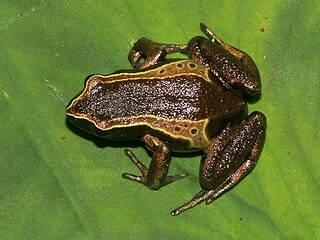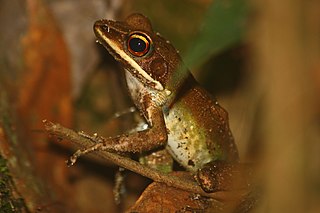
Cardioglossa is a genus of frogs in the family Arthroleptidae known as long-fingered frogs. They are native to western and central Africa, with the greatest species richness in Cameroon. They are found near streams in lowland and mountain forests, but also occur in other highland habitats near streams at up to 2,700 m (8,900 ft) in altitude. These are small frogs with a snout-to-vent length of 2 to 4 cm (0.8–1.6 in). Some of the more localized species are threatened.
Arthroleptis reichei is a species of frog in the family Arthroleptidae. It is found in the mountains of eastern and southern Tanzania and northern Malawi. It has several vernacular names: Poroto screeching frog, large-toad squeaker, Poroto Mountains screeching frog, and Reiche's squeaker. The specific name reichei honours Karl Friedrich Reiche, a German botanist.

Arthroleptis variabilis is a species of frog in the family Arthroleptidae. It is found in the lowlands of eastern Nigeria, Cameroon, Equatorial Guinea, Gabon, the Central African Republic, the Republic of the Congo, and the Democratic Republic of the Congo. Earlier records west from Nigeria refer to other species, including Arthroleptis krokosua described in 2008. Common names Buea screeching frog and variable squeaker frog have been coined for it.
Cardioglossa alsco is a species of frog in the family Arthroleptidae. It is endemic to Cameroon and is known from its type locality on southern slopes of the Tschabal Mbabo Mountains as well as from the Gotel Mountains, both in the Adamawa Region. Its range might extend into Nigeria. The specific name alsco is a patronym for the American Linen Supply Company (ALSCO). The company's German branch supported the expedition during which this species was discovered.
Cardioglossa cyaneospila is a species of frog in the family Arthroleptidae. It is endemic to the Albertine Rift area in eastern Democratic Republic of the Congo, southwestern Uganda, Rwanda, and southwestern Burundi. It was described in 1950 by Raymond Laurent based on specimens collected in 1949. No new records were published until 2011. Recent research has uncovered both old unpublished records and several new records, and the conservation status was changed from "data deficient" to "near threatened" in 2016. Common names Bururi long-fingered frog and Mukuzira long-fingered frog have been coined for this species.
Cardioglossa elegans is a species of frog in the family Arthroleptidae. It is found in southwestern Cameroon, Equatorial Guinea, and south to central Gabon. Common name elegant long-fingered frog has been coined for it.

Cardioglossa leucomystax is a species of frog in the family Arthroleptidae. It is found in large parts of Central Africa, extending into south-easternmost West Africa (Nigeria). The type locality is Cap Saint Jean in Equatorial Guinea. Populations from the Upper Guinean Forests of West Africa between Ghana and Sierra Leone previously allocated to this species were in 2008 described as a new species, Cardioglossa occidentalis. Common name silver long-fingered frog has been coined for Cardioglossa leucomystax.
Cardioglossa melanogaster is a species of frog in the family Arthroleptidae. It is found in the mountains of western Cameroon and eastern Nigeria. Common name Amiet's long-fingered frog has been coined for it.

Cardioglossa oreas is a species of frog in the family Arthroleptidae. It is endemic to Cameroon and known from the Western High Plateau between Mount Oku and the Bamboutos Mountains. Records from Mount Manengouba refer to Cardioglossa manengouba.
Cardioglossa pulchra is a species of frog in the family Arthroleptidae. It is found in the Cameroon Range in western Cameroon and in the Obudu Plateau in adjacent eastern Nigeria. Common name black long-fingered frog has been coined for it.
Cardioglossa schioetzi is a species of frogs in the family Arthroleptidae. It is found in the mountains of Cameroon and eastern Nigeria. Specifically, it has been recorded from the Oshie-Obudu Range, Gotel Mountains, Mount Oku, and Mount Mbam. It is a generally poorly known species.
Cardioglossa trifasciata is a species of frog in the family Arthroleptidae. It is endemic to western Cameroon and only known from the southern slopes of Mount Manengouba. Common name Nsoung long-fingered frog has been coined for it.
Cardioglossa venusta is a species of frog in the family Arthroleptidae. It is endemic to the mountains of western Cameroon. Specifically, it is known from Mount Manengouba, the Bamileke Highlands, Mount Nlonako, and the Rumpi Hills. Common name highland long-fingered frog has been coined for it.

Leptopelis aubryi, also known as the Aubry's tree frog and Gaboon forest treefrog, is a species of frog in the family Arthroleptidae. It is found in southeastern Nigeria, Cameroon, Central African Republic, Equatorial Guinea, Gabon, Republic of the Congo, western and northern Democratic Republic of the Congo, and Angola.

Leptopelis millsoni is a species of frog in the family Arthroleptidae. It is found in southeastern Nigeria, Cameroon, the Central African Republic, Equatorial Guinea, Gabon, the Republic of the Congo, the eastern Democratic Republic of the Congo, and northwestern Angola. Common names Niger forest treefrog and Millson's Tree Frog have been coined for it. There is a need of taxonomic revision of this taxon.

Amnirana albolabris is a species of frog in the family Ranidae. It is widely distributed in Sub-Saharan West and Middle Africa. However, the nominal species includes at least one undescribed species west of Benin; the formal taxonomic changes to split the species have not yet been done. Common names white-lipped frog and forest white-lipped frog has been coined for it, whereas Bamileke Plateau frog refers to now-synonymized Amnirana longipes.

Cardioglossa annulata, the annulated long-fingered frog, is a species of frog from the genus Cardioglossa native to Congo in elevations of 634 to 744 m. It lives in forests and wetlands in a 610 km2 (240 sq mi) area. It was scientifically described in 2015.
Cardioglossa congolia, the Congolian long-fingered frog, is a species of frog native to the Democratic Republic of Congo and Congo that is a member of the Cardioglossa genus. It's found in elevations of 474 to 515 m. Cardioglossa congolia is part of a subclade with five other species of the Cardioglossa genus, according to analysis of the mitochondrial 16S rRNA gene.
Cardioglossa inornata is a species of frog from the Cardioglossa genus. It is native to the Republic of Congo and the Democratic Republic of Congo. The species was first described in 1952 by Laurent. It lives in forests and wetlands and has an elevation range of 1,900 to 2,000 m.
Cardioglossa occidentalis, the western long-fingered frog, is a species of frog in the Cardioglossa genus native to Côte d'Ivoire, Liberia, Sierra Leone, Ghana and Guinea. They occur inland in wetlands and forests. They are found in elevations up to 650 m (2,130 ft). Despite the declining population, it is listed as Least Concern by the IUCN.







